
Surrealism - V
Antonio Luna
1910 – 1985

Antonio Rodríguez Luna
(July 22, 1910 – 1985) was a Spanish painter who developed most of his career while in exile in Mexico during the Spanish Civil War. He began his career young, while still studying in Madrid and before the war had already exhibited in various places in Europe. His opposition to Francisco Franco, forced him into exile, with intellectuals and artists in the country arranging his asylum. His career here included a Guggenheim Fellowship with major exhibitions in Washington DC and New York along with exhibitions at the Museo de Arte Moderno and the Palacio de Bellas Artes in Mexico. Despite his success, he never forgot his Spanish roots, with an exhibition in Madrid in 1971 and a return to his hometown of Montoro in 1981, after the death of Franco.
Rodríguez Luna was born in the town of Montoro in the Córdoba province of Spain. He began his art studies when he was thirteen, first at the Escuela de Bellas Artes in Seville. In 1927, he moved to Madrid to study at the Escuela de Bellas Artes there, meeting José Planes, Enrique Climent, Arturo Souto and Francisco Mateos, with whom he formed the Artistas Independientes group.
With the rise of Franco, he fled Spain, winding up in concentration camps in Argelès-sur-Mer and Brand, experiences represented in the later published Diez aguafuertes. Lázaro Cárdenas and a list of artists and intellectuals worked to bring him as an exile to Mexico City in 1939.
Rodríguez Luna lived in Mexico for forty six years. Although he developed his career in Mexico, he never forgot his Spanish roots. In the 1960s, Spanish cinematographers petitioned to let him back in the country to see his aging parents, but by the time he could do so, his father had died and his mother did not recognize him. He returned again in 1975 to exhibit at the Juana Mordó Gallery.
In 1981, after the death of Franco, Rodríguez Luna was able to return permanently to Spain, settling back in his hometown of Montoro, where he donated paintings to start a museum in his name. He continued to paint until his death in the town in 1985.

Antonio Rodriguez Luna - The Carlist Militiaman, 1937

Antonio Rodríguez Luna - The Dictator, 1937
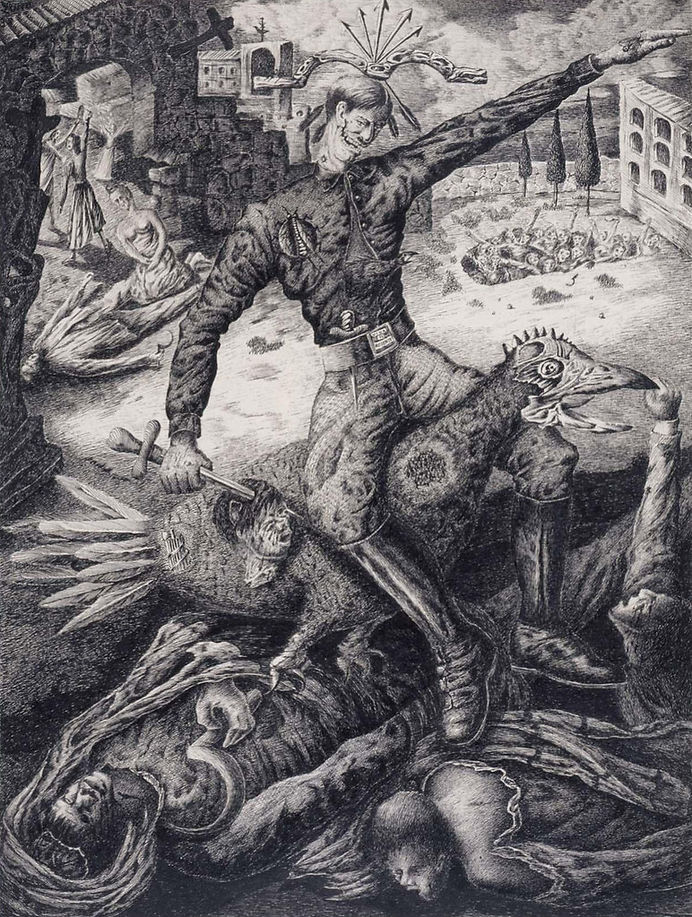
Antonio Rodríguez Luna - The Falangist, 1937

Antonio Rodríguez Luna - The Inquisition [of the Church, 1937

Antonio Rodríguez Luna - Land-Owner, 1938

Antonio Rodríguez Luna - Andalusian Land-Owner. 1937-38

Antonio Rodríguez Luna - Barcelona Air Raid, 1938

Antonio Rodríguez Luna - Homage to Bécquer, 1936

Antonio Rodríguez Luna - The Fifth Column, 1938

Antonio Rodríguez Luna - The War, 1938

Antonio Rodríguez Luna - They Also Give Land to the Peasants, 1937

Antonio Rodríguez Luna - Oviedo Prison, 1934

Antonio Rodríguez Luna - Air Raid on Colmenar Viejo, 1937

Antonio Rodríguez Luna - Víctimas de la aviación fascista

Antonio Rodríguez Luna - Bombardment of Colmenar Viejo (1937)
Rachel Baes
1912 – 1983

Rachel Baes
(1 August 1912 – 8 June 1983) was a Belgian surrealist painter. The growth of the women's movement in the late 20th century led to renewed interest in female artists and brought greater appreciation of their work. In 2002 the Royal Museum of Fine Arts Antwerp dedicated an exhibition to Baes and the female French-Belgian surrealist painter Jane Graverol.
Baesn was born on 1 August 1912 in Brussels to the painter, writer and art historian Émile Baes and his wife. Her father was a successful artist who was mainly known for his eroticized female nudes executed in a late Impressionist style. Rachel Baes was encouraged in her artistic efforts from an early age, although she never studied art formally.
In 1929, at age 17, Baes achieved her first recognition as an artist when she exhibited works at the Salon des Indépendants in Paris. There she was one of the members of the Surrealist group around René Magritte. She came to know André Breton, Jean Cocteau, Max Ernst, Georges Bataille, Irène Hamoir, and Paul Éluard.
Between 1936 and 1940, Baes had an affair with Joris Van Severen, the leader of Verdinaso, a far-right political party in Belgium. On the morning of the invasion of Belgium by German troops on 10 May 1940 Van Severen was arrested together with a number of other persons who were considered a danger to Belgium's national security. The arrested men were handed over to the French Army and incarcerated near Abbeville in France. On 20 May 1940, when the advancing German Army cut off the area, a group of French soldiers killed a number of the Belgian prisoners under their care including Van Severen, an event remembered as the a massacre. Baes published in 1965 a biography of Van Severen under the title Joris Van Severen, une âme.
From 1962, Baes retired from public life and lived alone in Bruges where she painted local subjects. She died in Bruges and was buried in Abbeville, alongside Van Severen.

Rachel Baes

Rachel Baes
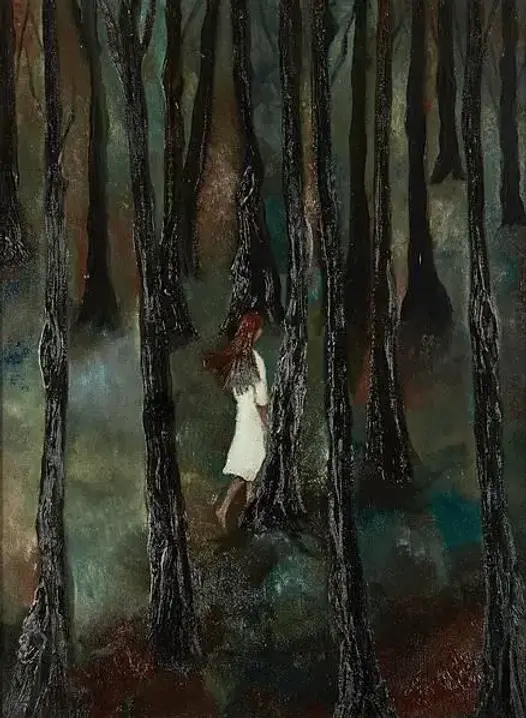
Rachel Baes

Rachel Baes

Rachel Baes
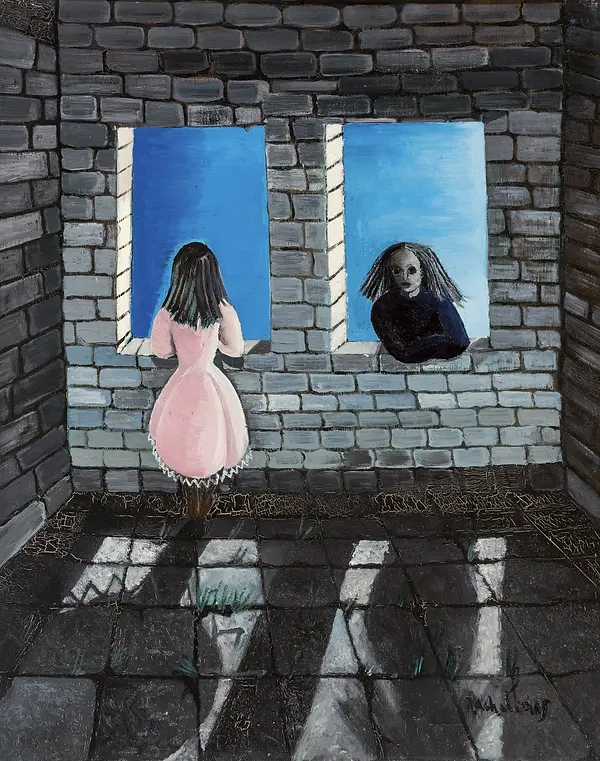
Rachel Baes

Rachel Baes

Rachel Baes

Rachel Baes

Rachel Baes

Rachel Baes

Rachel Baes

Rachel Baes

Rachel Baes

Rachel Baes

Rachel Baes

Rachel Baes

Rachel Baes
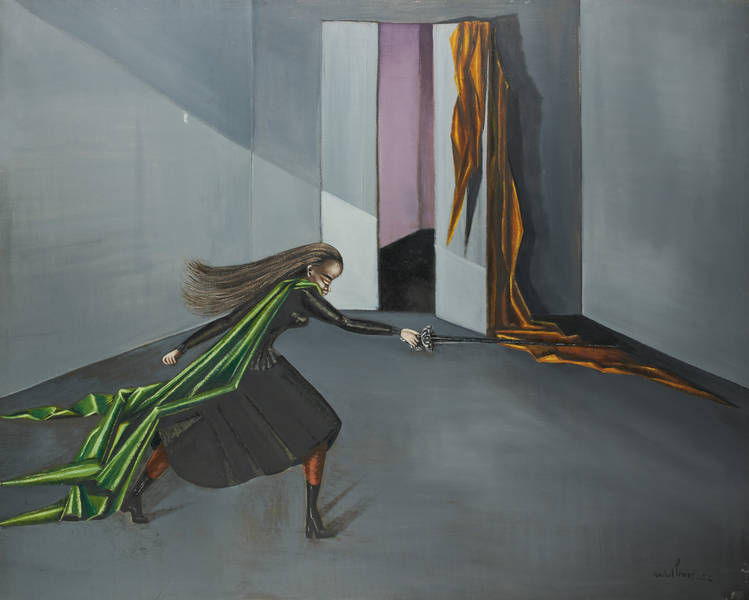
Rachel Baes

Rachel Baes

Rachel Baes

Rachel Baes

Rachel Baes

Rachel Baes
Leonora Carrington
1917 – 2011

Carrington and Max Ernst. She rejected male Surrealists’ views of women.
Photograph by Lee Miller /Lee Miller Archives, England
Leonora Carrington
(6 April 1917 – 25 May 2011).
Mexican painter, sculptor and writer of English birth. In 1936 she travelled to London, where she studied under Amédée Ozenfant and in 1937 met Max Ernst, with whom she became involved artistically and romantically, leading to her association with Surrealism. They moved to Paris together in 1937. At the outbreak of World War II, Ernst was interned as an enemy alien, and Carrington escaped to Spain, where she was admitted to a private clinic after having a nervous breakdown; she later recounted the experience in her book En bas (1943). After marrying the Mexican poet Renato Leduc in 1941 (a marriage of convenience), she spent time in New York before settling in Mexico in 1942, devoting herself to painting. There she and Remedios Varo developed an illusionistic Surrealism combining autobiographical and occult symbolism. Having divorced Leduc in 1942, in 1946 she married the Hungarian photographer Imre Weisz.

Leonora Carrington and Max Ernst

Max Ernst, Leonora Carrington, and Lee Miller

Paul Eluard, Leonora Carrington and Max Ernst at Lambe Creek. Photographed by Lee Miller

Leonora Carrington, André Breton, Marcel Duchamp, and Max Ernst, New York City, 1942; photograph by Hermann Landshoff. At center is Morris Hirshfield’s painting Nude at the Window (1941).

Leonora Carrington Self-Portrait
1937–38

Leonora Carrington Temple of the word
.jpg)
Leonora Carrington Big Badger Meets the Domino Boys
.jpg)
Leonora Carrington Les distractions de Dagobert

Leonora Carrington Chiki, ton pays
.jpg)
Leonora Carrington Untitled
.jpg)
Leonora Carrington Tuesday
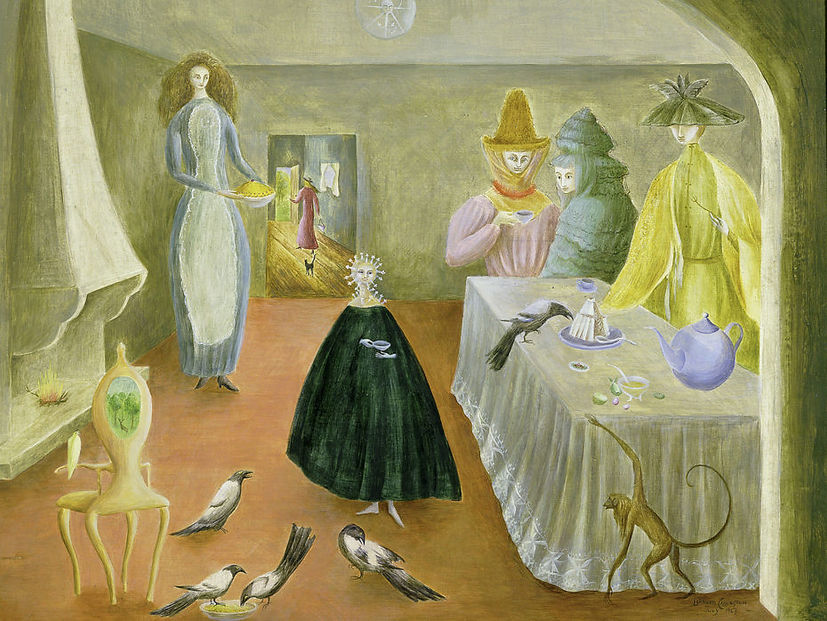
Leonora Carrington Leonora Carrington, The Old Maids

Leonora Carrington “Depictions of the English countryside and its traditions, clearly inspired by her childhood, materialise in her work, often connoting rigidity and structure.”

Leonora Carrington — Plain Chant.

Leonora Carrington – Three women with crows

Leonora Carrington — Figures carrying Still Life

Leonora Carrington The Temptation of St. Anthony
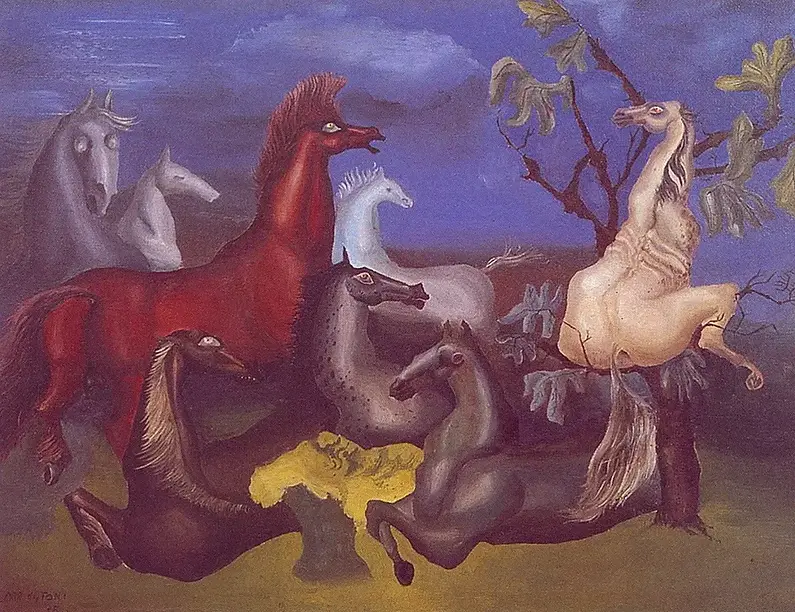
The horses of Lord Candlestick
Leonora Carrington
1938
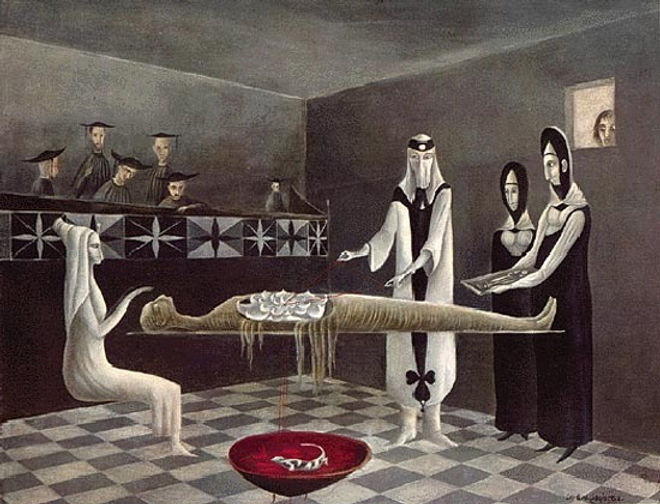
Leonora Carrington – Adieu Amenhotep

A magnificent bird. Portrait of Max Ernst
Leonora Carrington
1939
Kali
1918 – 1998
Kali (Hanna Weynerowska, born Hanna Gordziałkowska; (December 18, 1918 – June 20, 1998) was a Polish-born American painter known for her stylized portraits. She has been described as one of the most important Polish female painters. She was a World War II veteran of the Polish Resistance Movement after Nazi Germany occupied Poland, when she used the nom de guerre Kali. After emigrating and marrying, she used many variants of name, including "Hanna Kali Weynerowski", "Hanna Weynerowski-Kali", "Hanna Gordziałkowski-Weynerowski", "Hanka Weynerowska", and "Hanna Gordziałkowski", but she signed her paintings Kali.
The figures in her art resemble Old Masters in subject and positioning, but are painted in a simplified, flattened and more graphic manner. The paintings are brightly colored, often portraying the subject shown sitting at bust-length, with an elongated face, flattened body, a patterned element such as part of the clothing, and with the subject's hands positioned in a classical pose. Her work has been likened to a combination of Neo-mannerist and Surrealist.

Kali
Self Portrait

Kali

Kali

Kali

Kali
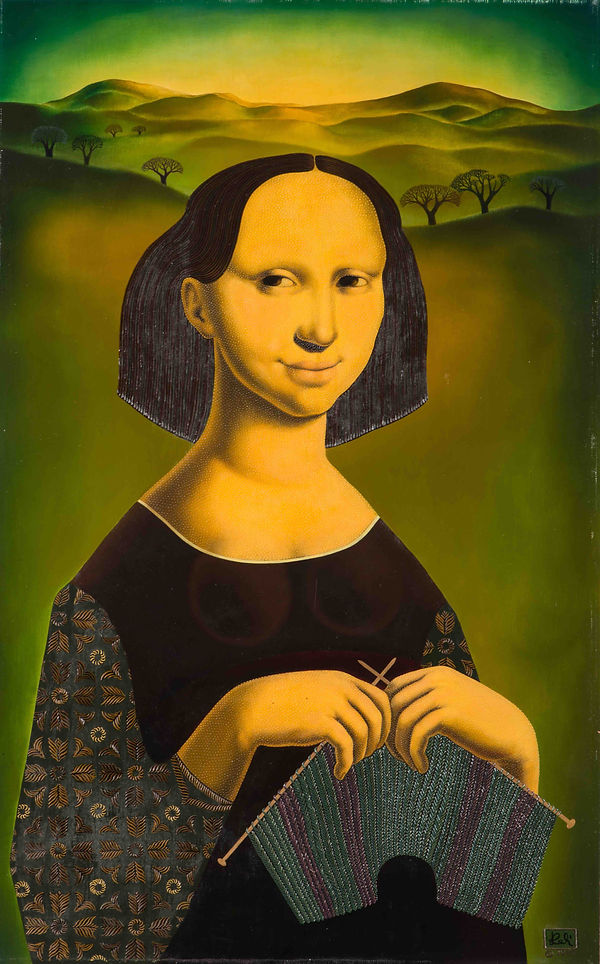
Kali

Kali

Kali

Kali

Kali

Kali

Kali

Kali

Kali

Kali

Kali

Kali

Kali
Pierre-Yves Tremois
1921 – 2020
Pierre-Yves Trémois (8 January 1921 – 16 August 2020) was a French visual artist and sculptor, known for evocative works drawing in equal proportions on surrealism and science illustration, and for combining graphic precision and rigor with flamboyant fantasy. He was born in Paris.
He held seat #2 in the engraving section at the Académie des Beaux-Arts.

Pierre-Yves Trémois
Self Portrait
Trémois: Variations on Love
Faithful friendship binds Pierre-Yves Trémois to Jean Rostand, whose Bestiaire d'amour he illustrated in 1957 with one hundred and fifty monotypes. Trémois, who received the grand prix in Rome in 1943, has turned his talents to illustrating. This year, he completes provocative drawings to accompany Verlaine’s Parallèlement, and Ovid’s Metamorphoses, with notes by a specialist on the fertilization of frogs. Jean Rostand states that Trémois lives his own version of Darwinian evolution.

Pierre-Yves Trémois
Pierre-Yves Trémois:
Jean Rostand - Bestiaire d'amour.
Verlaine - Parallèlement.
Ovid- Metamorphoses.

Pierre-Yves Trémois:
The Bestiary of a Dream

PIERRE YVES TRÉMOIS - MYTHOLOGI

Pierre Yves TREMOIS (1921-2020)
""Octopus Couple""
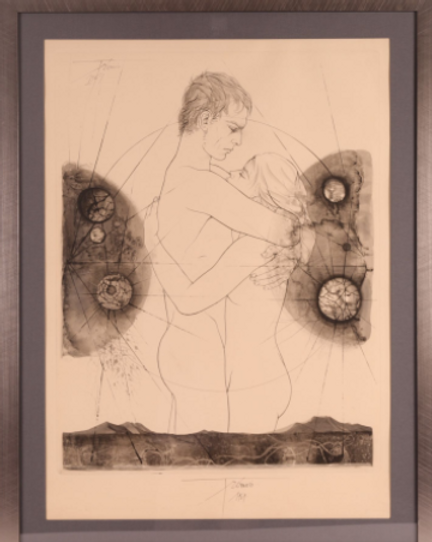
"ADAM ET ÈVE"
de Pierre-Yves TRÉMOIS (1921-2020)

Pierre Yves Tremois
Fin de l'homme

Rostand Jean, Trémois Pierre-Yves
Bestiaire D’amour

Rostand Jean, Trémois Pierre-Yves
Trémois, Le Singe, gravure extraite du grand livre illustré Le Bestiaire solaire, réalisé par André et Pierre Gonin

Rostand Jean, Trémois Pierre-Yves
Trémois, Le Singe, gravure extraite du grand livre illustré Le Bestiaire solaire, réalisé par André et Pierre Gonin

Rostand Jean, Trémois Pierre-Yves
Bestiaire solaire, L’Auroch
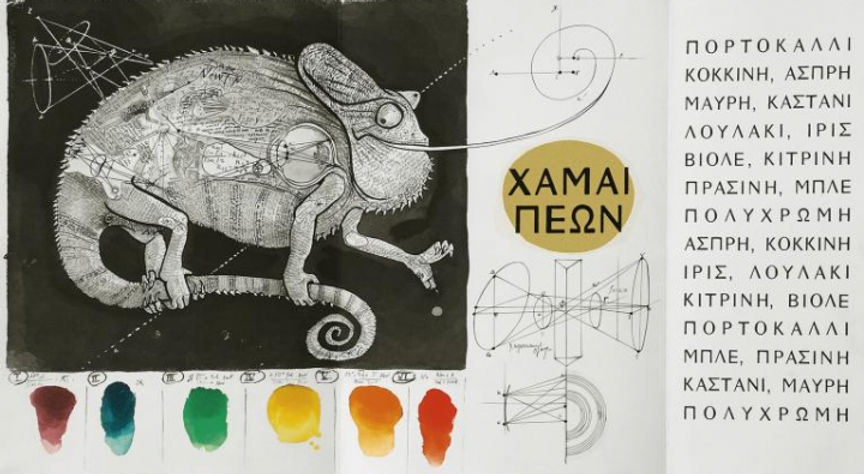
Rostand Jean, Trémois Pierre-Yves
Trémois, Le Singe, gravure extraite du grand livre illustré Le Bestiaire solaire, réalisé par André et Pierre Gonin

Rostand Jean, Trémois Pierre-Yves
Bestiaire solaire, La Chauve-souris

Rostand Jean, Trémois Pierre-Yves
BESTIAIRE SOLAIRE, LA SPHINGE

Rostand Jean, Trémois Pierre-Yves
Le Singe
JEAN

Trémois Pierre-Yves
Le Dromadaire et Le Mammouth, gravures extraites du grand livre illustré Le Bestiaire solaire, réalisé par André et Pierre Gonin,
éditeurs à Lausanne,

Rostand Jean, Trémois Pierre-Yves
Trémois, Crapauds accouplés, gravure extraite du grand livre illustré Le Bestiaire solaire
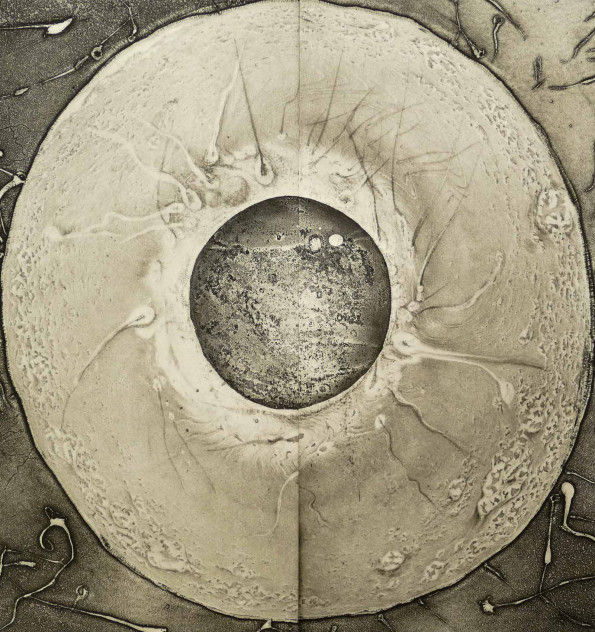
Rostand Jean, Trémois Pierre-Yves
Les limites de l'humain illustré Le Bestiaire solaire

Rostand Jean, Trémois Pierre-Yves
Bestiaire D’amour

Rostand Jean, Trémois Pierre-Yves
Bestiaire D’amour

Rostand Jean, Trémois Pierre-Yves
Bestiaire D’amour

Rostand Jean, Trémois Pierre-Yves
Bestiaire D’amour
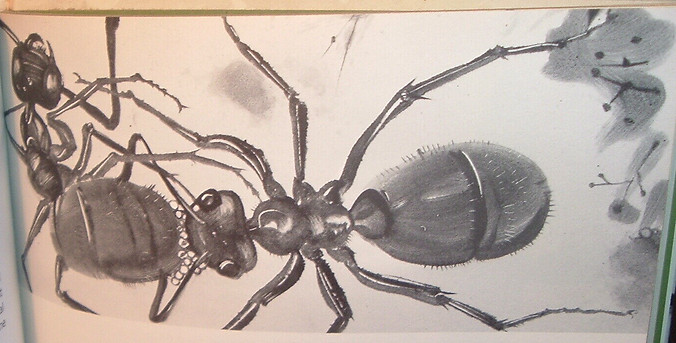
Rostand Jean, Trémois Pierre-Yves
Bestiaire D’amour

Rostand Jean, Trémois Pierre-Yves
Bestiaire D’amour

Rostand Jean, Trémois Pierre-Yves
Bestiaire D’amour

Rostand Jean, Trémois Pierre-Yves
Bestiaire D’amour

Rostand Jean, Trémois Pierre-Yves
Bestiaire D’amour

LOVERS
Pierre-Yves Trémois

Pierre Yves Tremois
Un Jour un Homme

Parallèlement - Paul Verlaine -
Pierre-Yves Trémois.
1969

Pierre Yves TREMOIS
“The embrace I”

Pierre Yves TREMOIS
“The embrace II”

Pierre Yves TREMOIS
LOVERS

Pierre-Yves Trémois
Untitled

Pierre Yves TREMOIS
LOVERS

Pierre-Yves Trémois
Untitled

Pierre-Yves Trémois
Untitled

Pierre Yves TREMOIS
LOVERS

Pierre-Yves Trémois
Vivarium 10

Métamorphoses
Pierre-Yves Trémois

Couple à l’ADN
Pierre-Yves Trémois

Couple à l’ADN
Pierre-Yves Trémois

Pierre-Yves TREMOIS - Gravure METAMORPHOSES. original 1968

THE EMBRACE
Pierre-Yves TREMOIS - Gravure METAMORPHOSES.
1968

Métamorphoses
Pierre-Yves Trémois

EROTIC HUG
Pierre-Yves Trémois

Métamorphoses
Pierre-Yves Trémois

Galate
Pierre-Yves Trémois

COUPLE
Pierre-Yves Trémois

Métamorphoses
Pierre-Yves Trémois

Métamorphoses
Pierre-Yves Trémois

Métamorphoses
Pierre-Yves Trémois

Métamorphoses
Pierre-Yves Trémois

Pierre-Yves TREMOIS
Europe and the Metamorphoses

Miserere
by Pierre-Yves Trémois
Miserere mei, Deus, Latin for "Have mercy on me, O God"

Pierre-Yves Trémois de
Hommage DÜRER

Pierre-Yves Trémois de
Hommage DÜRER
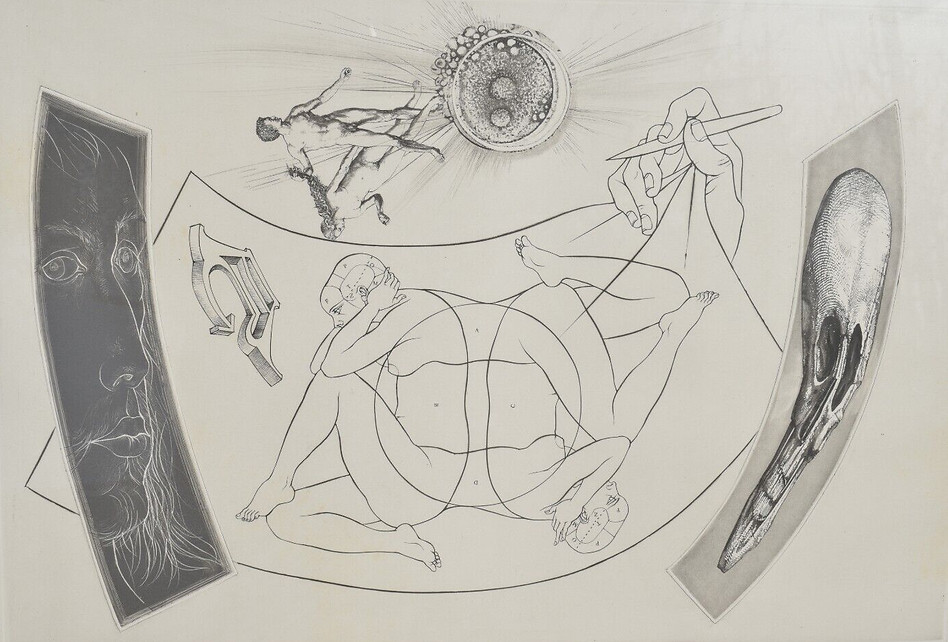
Pierre-Yves Trémois de
Hommage DÜRER

Pierre-Yves Trémois de
Hommage DÜRER

Pierre-yves Trémois,
Hommage à CRANACH
Judith et Holopherne, hommage à Cranach Judith and Holofernes, tribute to Lucas Cranach the Elder

Pierre-yves Trémois,
Hommage à CRANACH
Judith et Holopherne, hommage à Cranach Judith and Holofernes, tribute to Lucas Cranach the Elder

Pierre Yves TREMOIS
NIETZSCHE (Fsse Homo).

Pierre Yves TREMOIS
NIETZSCHE (Fsse Homo).

Pierre Yves TREMOIS
NIETZSCHE (Fsse Homo).

Pierre Yves TREMOIS
NIETZSCHE (Fsse Homo).

Pierre Yves TREMOIS
NIETZSCHE (Fsse Homo).

Pierre Yves TREMOIS
NIETZSCHE (Fsse Homo).
VENERA LA MATERNITI
Jose Manuel Capuletti
1925 — 1978
Jose Manuel Capuletti
(March 21, 1925 in Valladolid, Spain — 1978) was a Spanish painter whose work was strongly influenced by surrealism. His work has been collected by among others the Duke and Duchess of Windsor, Arthur Rubenstein, Charles Boyer, and Juan Carlos the former King of Spain. The Russian-American writer Ayn Rand was an admirer of his work.
Capuletti maintained a studio in Paris and exhibited with the Hammer galleries in New York City. His model and muse was often his wife, Pilar. With the Spanish bullfighter Ángel Peralta Pineda Capuletti created the book Caballo torero which was published in 1971. Capuletti also worked as set and costume designer for the dance recitals including for the José Greco company.

José Manuel Capuletti. Self Portrait

José Manuel Capuletti.
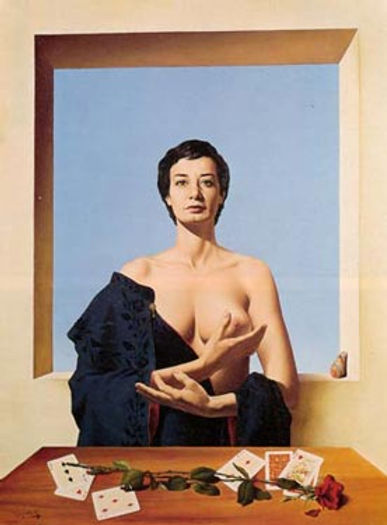
José Manuel Capuletti.

José Manuel Capuletti.

José Manuel Capuletti.

José Manuel Capuletti.

José Manuel Capuletti.

José Manuel Capuletti.

José Manuel Capuletti.

José Manuel Capuletti.

José Manuel Capuletti.
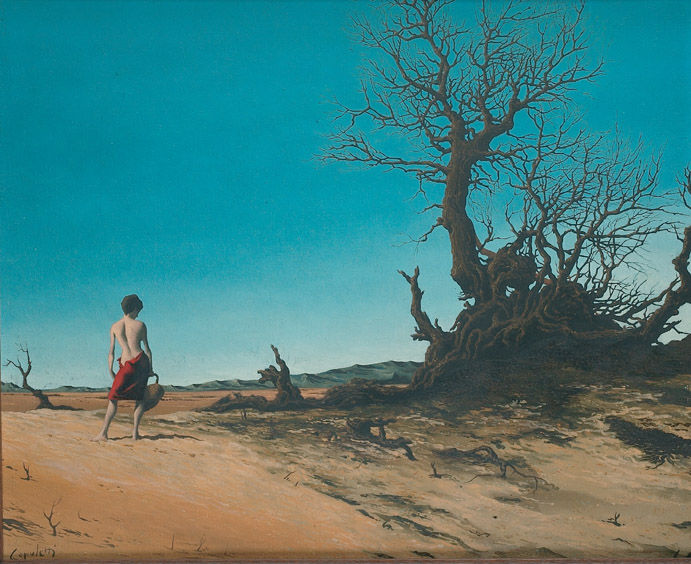
José Manuel Capuletti.

José Manuel Capuletti.

José Manuel Capuletti.

José Manuel Capuletti.

José Manuel Capuletti.

José Manuel Capuletti.

José Manuel Capuletti.

José Manuel Capuletti.

José Manuel Capuletti.

José Manuel Capuletti.

José Manuel Capuletti.
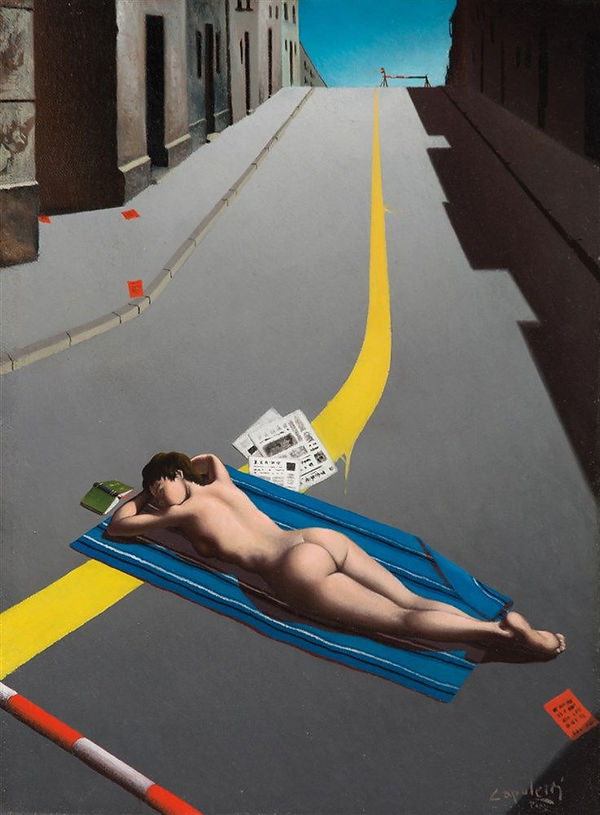
José Manuel Capuletti.

José Manuel Capuletti.

José Manuel Capuletti.

José Manuel Capuletti.